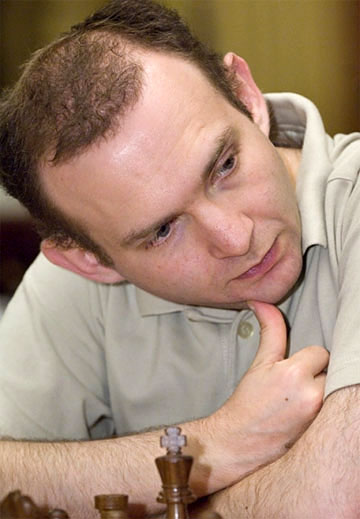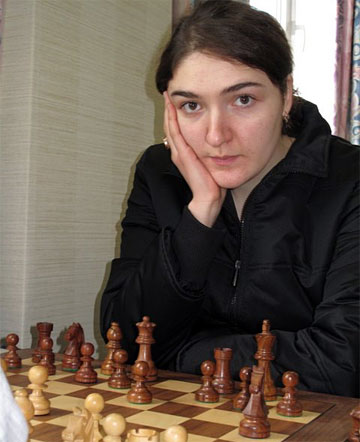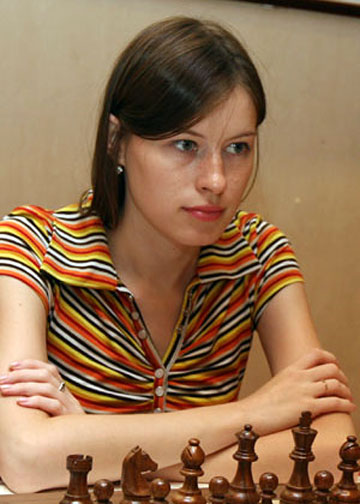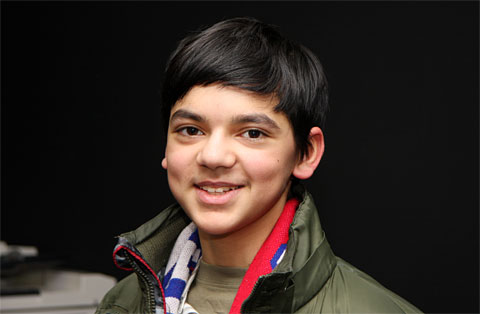| Latest | Greatest | Lobby | Journals | Search | Options | Help | Login |
|
|
|
This topic is archived. |
| Home » Discuss » Topic Forums » Sports |
|
| Jack Rabbit
|
Sun Feb-08-09 01:51 PM Original message |
| The Jack Rabbit Chess Report (February 8): Svidler takes the Rock; A Yank wins Moscow Open |
|
Edited on Sun Feb-08-09 01:53 PM by Jack Rabbit
Svidler takes a piece of the Rock in Gibraltar
 Independent (UK) Reigning Russian national champion Peter Svidler of St. Petersburg won the Gibtelecom Masters Tournament when he defeated Soviet Russian native and now Swiss grandmaster Vadim Milov in a two-round rapid playoff Thursday in Gibraltar. Both grandmasters finished the regular 10-round event with 8 points. The final round started Thursday with Svidler, Milov and three other players -- Vugar Gshimov of Azerbaijan, Hikaru Nakamura of the United States and Pentala Harikrishna of India -- tied for first place with 7 points each. Gashimov, who had been in or near the lead throughout the tournament, and Nakamura, who won four games in a row emerge as one of the leaders, played each other to a draw while Svidler defeated Pentala and Milov, playing Black, defeated reigning Israeli champion Boris Avrukh to set up the playoff. A prize of �6000 was awarded to newly-minted grandmaster Nana Dzagnidze of Georgia for the best performance by a woman in the event. She scored 7 points out of ten with 5 wins, one loss and 4 draws and a performance rating for the tournament of 2675. Ms. Dzagnidze richly deserved the prize as she played not only winning chess, but brilliant chess. Alex Onischuk Wins Moscow Open  Former US champion Alex Onischuk, 33, a native of then-Soviet Ukraine and now a resident of Baltimore, won the annual Moscow Open completed earlier today with 7� points in nine games. Onischuk played a short draw yesterday with another expatriate of the former Soviet Union, two-time Dutch national champion Sergei Tiviakov, to assure himself of at least a tie for first place. Romanian GM Viorel Iordachescu drew his game with Russian GM Ernesto Inarkiev and Young Russian GM Ian Nepomniachtchi drew against his compatriot Alexey Korotylev, all four failing to catch Onischuk in the final standings. They and Tiviakov finished in a five-way tie for second with 7 points each. The ladies' competition in Moscow was won by Russian WGM Natalija Pogonina with 8 points in nine rounds, a full point ahead of her nearest rivals. The second place finishers were Russians Svetlana Matveeva, Valentina Guinina and Tatjana Molchanova, Bathuyag Mongontuul of Mongolia and Gu Xiaobing of China. Many of the participants of the Moscow Open, including Mr. Onischuk, will remain in Moscow to play in the annual Aeroflot Open beginning a week from tomorrow. Calendar Aeroflot Open, Moscow 16-27 February. Topalov-Kamsky World Championship Semifinal Match, Sofia 16-28 February. Eight Rounds. Winner will challenge Anand for the world championship. Linares Grandmaaster Tournament 18 February-8 March. Cappelle la Grande Open 28 February-7 March. Reykjavik Open 4-13 March. European Individual Championships, Budva (Montenegro) 5-19 March. Foxwoods Open, Mashantucket, Connecticut April 8-12. MTel Masters, Sofia May 9-19. Aerosvit International Tournament, Foros (Ukraine) June 9-20. |
| Printer Friendly | Permalink | | Top |
| Jack Rabbit
|
Sun Feb-08-09 01:54 PM Response to Original message |
| 1. This week's games |
|
Your humble hare acknowledges the assistance of Fritz 6.0 on analysis. Diagrams on the Jack Rabbit Chess Report are made with Chess M�rida, a true type font that can be downlaoded free here. !""""""""# $tMvWlVmT% $OoOoOoOo% $ + + + +% $+ + + + % $ + + + +% $+ + + + % $pPpPpPpP% $RnBqKbNr% /(((((((() WHITE White to move (This position is a theoretical draw) |
| Printer Friendly | Permalink | | Top |
| Jack Rabbit
|
Sun Feb-08-09 01:56 PM Response to Reply #1 |
| 2. Svidler - Pentala, Round 10, Gibraltar |
 Peter Svidler Peter Svidler - Pentala Harikrishna Gibtelecom Masters, Round 10 Gibraltar, 5 February 2009 Spanish Grand Royal Game: Breyer Defense 1.e4 e5 2.Nf3 Nc6 3.Bb5 a6 4.Ba4 Nf6 5.0-0 Be7 6.Re1 b5 7.Bb3 d6 8.c3 0-0 9.h3 Nb8
10.d4 Nbd7 11.Nbd2 Bb7 12.Bc2 Re8
13.a4
13...Bf8 14.Bd3 c6 15.b3
15...g6 16.Qc2 Rc8 17.Ba3!?
17...Qb6 18.Bf1
!""""""""# $ +t+tVl+% $+v+m+oVo% $oWoO Mo+% $+o+ O + % $p+ Pp+ +% $Bp+ +n+p% $ +qN Pp+% $R + RbK % /(((((((() WHITE: Peter Svidler Position after 18.Bd3f1 18...Nh5!?
19.g3
19...exd4
20.cxd4 c5 21.axb5 axb5 22.Qd3 Ba6?!
23.Bb2 d5 24.dxc5
24...Nxc5 25.Qd4
25...Bg7
!""""""""# $ +t+t+l+% $+ + +oVo% $vW + +o+% $+oMo+ +m% $ + Qp+ +% $+p+ +nPp% $ B N P +% $R + RbK % /(((((((() WHITE: Peter Svidler Position after 25...Bf8g7 26.e5!
26...Qb7 27.Rec1 Ne6 28.Rxc8!
28...Rxc8
29.Qe3 Bf8 30.Nd4
30...Nxd4
31.Bxd4 Ng7 32.Nf3 Ne6 33.h4!?
33...Nxd4 34.Nxd4 Bc5 35.b4
35...Bxb4 36.e6 Re8
37.Qb3 Bc5 38.Bg2 f6
39.Qc3!
39...Be7?
!""""""""# $ + +t+l+% $+w+ V +o% $v+ +pOo+% $+p+o+ + % $ + N + P% $+ Q + P % $ + + Pb+% $R + + K % /(((((((() WHITE: Peter Svidler Position after 39...Bc5e7 40.Qa5!
40...Bc5 41.Nb3 Bxf2+
42.Kxf2
42...Qa7+ 43.Kf1 Qe3
44.Qxa6 Qxb3 45.Qa3 Qc4+
46.Kg1 b4 47.Qa7 Kh8
48.Qd7 Qc5+ 49.Kh2 Qe7 50.Bxd5 1-0
The multi-talented and good-natured Peter Svidler as you have never seen him before: please click here. |
| Printer Friendly | Permalink | | Top |
| Jack Rabbit
|
Sun Feb-08-09 01:58 PM Response to Reply #1 |
| 3. Milov - Kotronias, Round 8, Gibraltar |
 Vadim Milov Vadim Milov - Vasilios Kotronias Gibtelecom Masters, Round 8 Gibraltar, 3 February 2009 East India Game: Nimzo-Indian Defense (Rubinstein Opening) 1.d4 Nf6 2.c4 e6 3.Nc3 Bb4 4.e3 0-0 5.Nge2
5...d5 6.a3 Bd6
7.c5 Be7 8.b4 Nbd7
9.Ng3!?
9...a5
10.b5 e5
11.Be2
11...exd4
12.exd4 Re8 13.0-0 b6
!""""""""# $t+vWt+l+% $+ OmVoOo% $ O + M +% $OpPo+ + % $ + P + +% $P N + N % $ + +bPpP% $R Bq+rK % /(((((((() WHITE: Vadim Milov Position after 13...b7b6 14.c6!
14...Nf8 15.f4
15...Ne6 16.Kh1!?
16...Ne4
17.Ncxe4 dxe4 18.Be3
18...Bf6
!""""""""# $t+vWt+l+% $+ O +oOo% $ Op+mV +% $Op+ + + % $ + PoP +% $P + B N % $ + +b+pP% $R +q+r+k% /(((((((() WHITE: Vadim Milov Position after 18...Be7f6 19.f5!!
19...Nxd4
20.Bc4 a4
21.Qh5!
21...Qe7 22.Bxd4 Bxd4 23.Rae1!
23...e3 24.Rf4 Rd8 25.h3?!
25...Bc3?
26.Re4!
26...Qf6 27.R1xe3 g6 28.fxg6 Kf8 29.gxf7 1-0
|
| Printer Friendly | Permalink | | Top |
| Jack Rabbit
|
Sun Feb-08-09 02:00 PM Response to Reply #1 |
| 4. Berkes - Dzagnidze, Round 9, Gibraltar |
 Nana Dzagnidze Ferenc Berkes - Nana Dzagnidze Gibtelecom Masters. Round 9 Gibraltar, 4 February 2009 East India Game: Nimzo-Indian Defense 1.d4 Nf6 2.c4 e6 3.Nc3 Bb4 4.f3 0-0
5.a3 Bxc3+ 6.bxc3 Nh5
7.Nh3 f5 8.e4
8...fxe4!?
9.Be2
9...e5!?
10.0-0
10...d6 11.fxe4 Bxh3
!""""""""# $tM W Tl+% $OoO + Oo% $ + O + +% $+ + O +m% $ +pPp+ +% $P P + +v% $ + +b+pP% $R Bq+rK % /(((((((() WHITE: Ferenc Berkes Position after 11...Bc8h3:N 12.Bxh5!
12...Be6 13.Rxf8+ Qxf8 14.Ra2
14...Nd7
15.Rf2 Nf6 16.c5 h6 17.Qf1!?
17...Qe7 18.cxd6 cxd6
19.Bg6 Rf8 20.a4?!
!""""""""# $ + + Tl+% $Oo+ W O % $ + OvMbO% $+ + O + % $p+ Pp+ +% $+ P + + % $ + + RpP% $+ B +qK % /(((((((() WHITE: Ferenc Berkes Position after 20.a3a4 20...Bf7!
21.Bf5
21...exd4 22.cxd4 Nxe4
23.Rf3 Nf6 24.Re3 Qc7 25.Rg3
25...Kh8
26.Bd3 Bg8!
27.Bd2 Bh7 28.Bc4
28...Be4 29.a5 d5 30.Be2
30...Qe7 31.Qe1 Qe6 32.Rb3
32...Rf7 33.Bf4?
!""""""""# $ + + + L% $+ + +tO % $ + +wM O% $P +o+ + % $ + PvB +% $+r+ + + % $ + +b+pP% $+ + Q K % /(((((((() WHITE: Ferenc Berkes Position after 33.Bd2f4 33...Bxg2!!
34.Kxg2 Qe4+ 35.Rf3 g5 36.Bxg5
36...hxg5 37.Kf1 Ng4 0-1
|
| Printer Friendly | Permalink | | Top |
| Jack Rabbit
|
Sun Feb-08-09 02:03 PM Response to Reply #1 |
| 5. Beliavsky - Dzagnidze, Round 5, Gibraltar |
|
Nana Dzagnidze was defeated only once in Gibraltar, by former four-time Soviet champion Alexander Beliavsky, who now plays under the Slovenian flag.
Beliavsky was among the tournament leaders at the half-way point, but faltered in the later rounds.  Alexander Beliavsky Alexander Beliavsky - Nana Dzagnidze Gibtelecom Masters, Round 5 Gibraltar, 31 January 2009 East India Game: Nimzo-Indian Defense (Keres Variation) 1.d4 Nf6 2.c4 e6 3.Nc3 Bb4 4.Qc2 0-0 5.a3 Bxc3+ 6.Qxc3 b6 7.Bg5 Bb7 8.e3 d6 9.Ne2
9...Nbd7 10.Qc2
10...c5 11.Rd1 cxd4
12.Rxd4 Qc7
13.Nc3 d5!?
14.cxd5 Bxd5
15.Bd3?!
15...Rfc8?!
16.0-0 h6 17.Bh4 e5
18.Ra4 Bc6
19.Rc4 Qb7 20.Rc1?!
20...Bxg2!
21.Nb5 Rxc4 22.Bxc4 Be4?!
23.Nd6!
23...Bxc2 24.Nxb7 Be4
25.Nd6 Bd5 26.Bb5 Nc5?!
!""""""""# $t+ + +l+% $O + +oO % $ O N M O% $+bMvO + % $ + + + B% $P + P + % $ P + P P% $+ R + K % /(((((((() WHITE: Alexander Beliavsky Position after 26...Nd7c5 27.Bxf6!
27...gxf6
28.b4
28...Ne6 29.Rc8+ Nd8 30.Rxa8 Bxa8 31.Nc8
31...Kf8 32.Nxa7
32...Bb7 33.Be2 Ke7
34.Nb5?!
!""""""""# $ + M + +% $+v+ Lo+ % $ O + + O% $+n+ Oo+ % $ P + + +% $P + P + % $ + +nP P% $+ + + K % /(((((((() WHITE: Alexander Beliavsky Position after 34.Na7b5 34...f5!
35.Nc3 Kd6 36.Kf1 f6
37.Bd3
37...Bc8 38.Kg2 Nc6 39.Kg3 e4 40.Be2 Be6?!
41.Nb5+ Ke5
42.Nc7 Ne7
43.Nxe6 Kxe6 44.Kh4 Ke5?
45.Kh5!
45...Nd5
46.Kxh6 f4 47.exf4+ Nxf4 48.Bf1 Nd3
49.f3 f5 50.fxe4
50...fxe4 !""""""""# $ + + + +% $+ + + + % $ O + + K% $+ + L + % $ P +o+ +% $P +m+ + % $ + + + P% $+ + +b+ % /(((((((() WHITE: Alexander Beliavsky Position after 50...fe4:p 51.Kg5!
51...Ne1
52.h4 Nf3+ 53.Kh5 e3
54.a4!
54...Nd4 55.a5 bxa5
56.bxa5
56...Kd6 57.a6 Kc7 58.Kg4 e2
!""""""""# $ + + + +% $+ L + + % $p+ + + +% $+ + + + % $ + M +kP% $+ + + + % $ + +o+ +% $+ + +v+ % /(((((((() WHITE: Alexander Beliavsky Position after 58...e3e2 59.Bxe2!
59...Nxe2
60.h5 Nc3 61.h6 Ne4 62.Kf5 Nd6+ 63.Kg6 1-0
|
| Printer Friendly | Permalink | | Top |
| Jack Rabbit
|
Sun Feb-08-09 02:05 PM Response to Reply #1 |
| 6. Gashimov - Beliavsky, Round 7, Gibraltar |
 Vugar Gashimov Vugar Gashimov - Alexander Beliavsky Gibtelecom Masters, Round 7 Gibraltar, 2 February 2009 Spanish Grand Royal Game: Sofia Anti-Marshall Opening 1.e4 e5 2.Nf3 Nc6 3.Bb5 a6 4.Ba4 Nf6 5.0-0 Be7 6.Re1 b5 7.Bb3 0-0 8.h3
8...Bb7 9.d3 d6 10.a3
10...Na5
11.Ba2 c5 12.Nc3
12...Nc6 13.Bg5
13...Nd7
14.Bd2 Nb6 15.Ne2!?
15...Bc8
16.b4
16...c4!?
17.Be3 Be6 18.Nc3 Rc8
!""""""""# $ +tW Tl+% $+ + VoOo% $oMmOv+ +% $+o+ O + % $ Po+p+ +% $P NpBn+o% $b+p+ Oo+% $R +qR K % /(((((((() WHITE: Vugar Gashimov Position after 18...Ra8c8 19.Bxb6!
19...Qxb6 20.dxc4 bxc4
21.Nd5 Bxd5
22.exd5 Na7 23.Nd2 c3
24.Nc4 Qb5?
!""""""""# $ +t+ Tl+% $M + VoOo% $p+ O + +% $+w+pO + % $ Pm+ + +% $P O + +p% $ +p+ Pp+% $R +qR K % /(((((((() WHITE: Vugar Gashimov Position after 24...Qb6b5 25.Qd3!
25...Rc7 26.Rad1
26...Rfc8
27.Nxe5?!
27...Qxd3?!
28.Rxd3 Bf8
29.Nc6!
29...Nxc6 30.dxc6 Rxc6 31.Bd5
31...R6c7 32.a4 g6
33.Rb1!?
33...Rb8 !""""""""# $ T + Vl+% $+ T +o+o% $o+ O +o+% $+ +b+ + % $pP + + +% $+ Or+ +r% $ +p+ Pp+% $+r+ + K % /(((((((() WHITE: Vugar Gashimov Position after 33...Rc8b8 34.b5!
34...axb5 35.Rxb5 Re8
36.Kf1 Bh6
37.Rd1 Bd2 38.g3 Rce7 39.Kg2
39...Re2
40.Bf3 R2e5 41.Rdb1 R8e7
42.a5!
42...Rxb5 43.Rxb5 Re1
!""""""""# $ + + +l+% $+ + +o+o% $ + O +o+% $Pr+ + + % $ + + + +% $+ O +vPp% $ +pV Pk+% $+ + T + % /(((((((() WHITE: Vugar Gashimov Position after 43...Re7e1 44.a6!!
44...Ra1 45.Be2 Kf8 46.Rb7 d5
47.Rd7 Bg5 48.a7 1-0
|
| Printer Friendly | Permalink | | Top |
| Jack Rabbit
|
Sun Feb-08-09 02:07 PM Response to Reply #1 |
| 7. Zherebakh - Onischuk, Open General, Round 4, Moscow |
 Alex Onischuk Yaroslav Zherebukh - Alex Onischuk Moscow Open (General Competition), Round 4 Moscow, 3 February 2009 Italian Royal Game: Gothic Defense (Two Knights' Defense) 1.e4 e5 2.Nf3 Nc6 3.Bc4 Nf6 4.Ng5
4...d5
5.exd5 Na5
6.Bb5+
6...c6 7.dxc6 bxc6 8.Qf3
8...Be7
9.Bxc6+
9...Nxc6 10.Qxc6+ Bd7 11.Qf3 0-0 12.0-0!?
12...Ng4!?
13.h3
13...Nxf2 14.Qxf2 Bxg5
15.Nc3 f5 16.d4 Bh4
17.Qe3 e4 18.Ne2
18...Qc8 19.Nc3
19...Rb8
20.b3
20...Qc7 21.Ba3 f4 22.Nd5?
22...fxe3!
23.Nxc7 e2 24.Rfe1 Bf2+!
25.Kh2
!""""""""# $ T + Tl+% $O Nv+ Oo% $ + + + +% $+ + + + % $ + Po+ +% $Bp+ + +p% $p+p+oVpK% $R + R + % /(((((((() WHITE: Alex Onischuk Position after 25.Kg1h2 25...Bxd4!!
26.Bxf8 Rxf8 27.Rac1
27...Be5+ 28.Kh1 Bxc7 29.Rxe2 Bc6
30.c4 e3 31.Kg1 Rd8 32.Rxe3
!""""""""# $ + T +l+% $O V + Oo% $ +v+ + +% $+ + + + % $ +p+ + +% $+p+ R +p% $p+ + +p+% $+ R + K % /(((((((() WHITE: Alex Onischuk Position after 32.Re2e3:p 32...Bf4!
33.Re6 0-1
|
| Printer Friendly | Permalink | | Top |
| Jack Rabbit
|
Sun Feb-08-09 02:10 PM Response to Reply #1 |
| 8. Pogonina - Solovjova, Open Women's, Round 4, Moscow |
 Natalija Pogonina Natalija Pogonina - Valentina Solovjova Moscow Open (Women's Group), Round 4 Moscow, 3 February 2009 Open German Game: Seirawan Defense (Caro-Kann Defense) 1.e4 c6 2.d4 d5 3.Nc3 dxe4 4.Nxe4 Bf5 5.Ng3 Bg6 6.h4 h6 7.Nf3 Nd7
8.Bd3
8...Bxd3 9.Qxd3 Qc7
10.Bd2 Ngf6 11.0-0-0 e6 12.Ne4
12...0-0-0 13.g3
13...Nxe4 14.Qxe4 Nf6
15.Qe2 Bd6 16.c4
16...c5!?
17.Bc3
17...cxd4 18.Nxd4
18...a6 19.Kb1 Rd7 20.Nb3 Qc6?!
21.Bxf6! gxf6 22.c5 Bc7 23.Rxd7
23...Qxh1+
24.Rd1 Qc6
!""""""""# $ +l+ + T% $+oV +o+ % $o+w+oO O% $+ P + + % $ + + + P% $+n+ + P % $pP +qP +% $+k+r+ + % /(((((((() WHITE: Natalija Pogonina Position after 24...Qa1c6 25.Qh5!
25...Rd8 26.Rxd8+ Bxd8 27.a3
27...Qe4+ 28.Ka2 a5 29.Qxh6
29...a4 30.Nc1 Qc4+ 31.Kb1 Qxc5
32.Qf4!
32...Qb5
33.Qd4 Bc7
34.Nd3 Qf5
35.g4!?
35...Qh7 36.Ka2!?
36...e5?
!""""""""# $ +l+ + +% $+oV +o+w% $ + + O +% $+ + O + % $o+ Q +pP% $P +n+ + % $kP + P +% $+ + + + % /(((((((() WHITE: Natalija Pogonina Position after 36...e6e5 37.Qd5!
37...Qxh4 38.f3 b6
39.Qa8+ Kd7 40.Nb4 f5
41.Qc6+ Kd8 42.Nd5 Bb8
43.Nxb6 Ke7 44.Qb7+ Ke6 45.Qd7+! 1-0
|
| Printer Friendly | Permalink | | Top |
| Jack Rabbit
|
Sun Feb-08-09 02:17 PM Response to Reply #1 |
| 9. Giri - Gupta, Corus C, Round 10, Wijk aan Zee |
|
Anish Giri, the child of a Russian mother and Nepalese father, is a fourteen-year-old talent. He plays under the auspices of Russia but lives with his parents in Holland.
He entered Wijk aan Zee as a federation master. He finished second in Group C behind Wesley So, who himself is only 15, and received his third grandmaster norm. Anish will become a GM when he can get his rating over 2500. In this game he defeats the reigning world junior champion, Abhijeet Gupta of India.  Anish Giri Anish Giri - Abhijeet Gupta Corus Chess Tournament (Group C), Round 10 Wijk aan Zee, 28 January 2009 West India Game: Indian Queen's Gambit (Exchange Opening) (Gr�nfeld Defense) 1.d4 Nf6 2.c4 g6 3.Nc3 d5 4.cxd5 Nxd5 5.Bd2!?
5...Nb6
6.Nf3 Bg7 7.Bg5
7...0-0 8.e3 h6
9.Bh4 c5 10.dxc5 N6d7 11.Rc1 Nc6
12.Bb5 Nxc5 13.0-0 g5 14.Bg3 Bf5
15.Qd5 Qxd5 16.Nxd5 Nd3?
!""""""""# $t+ + Tl+% $Oo+ OoV % $ +m+ + O% $+b+n+vO % $ + + + +% $+ +mPnB % $pP + PpP% $+ R +rK % /(((((((() WHITE: Anish Giri Position after 16...Nc5d3 17.Bxc6!!
17...Nxc1
18.Rxc1 Bxb2 19.Rc5 Rad8 20.h3
20...Be6 21.Bxb7 Bxd5 22.Bxd5
22...Ba3 23.Ra5 Bb4 24.Rb5 a6 !""""""""# $ + T Tl+% $+ + Oo+ % $o+ + + O% $+r+b+ O % $ V + + +% $+ + PnBp% $p+ + Pp+% $+ + + K % /(((((((() WHITE: Anish Giri Position after 24...a7a6 25.Bxf7+?!
25...Rxf7
26.Rxb4 Rd1+ 27.Kh2 Rf6 28.h4
28...Rg6 29.Rb8+ Kg7 30.Be5+ Kf7 31.Bd4 Rd6
32.hxg5 hxg5 33.Nxg5+ 1-0
|
| Printer Friendly | Permalink | | Top |
| Jack Rabbit
|
Thu Feb-12-09 02:57 PM Response to Original message |
| 10. DUers should appriciate Alex Onischuk's fashion statement |
|
Please click here to see the photo of Moscow Open champions Natalija Pogonina of Russia and Alex Onischuk of the United States.
|
| Printer Friendly | Permalink | | Top |
| DU
AdBot (1000+ posts) |
Tue Apr 23rd 2024, 08:59 PM Response to Original message |
| Advertisements [?] |
| Top |
| Home » Discuss » Topic Forums » Sports |
|
Powered by DCForum+ Version 1.1 Copyright 1997-2002 DCScripts.com
Software has been extensively modified by the DU administrators
Important Notices: By participating on this discussion board, visitors agree to abide by the rules outlined on our Rules page. Messages posted on the Democratic Underground Discussion Forums are the opinions of the individuals who post them, and do not necessarily represent the opinions of Democratic Underground, LLC.
Home | Discussion Forums | Journals | Store | Donate
About DU | Contact Us | Privacy Policy
Got a message for Democratic Underground? Click here to send us a message.
© 2001 - 2011 Democratic Underground, LLC